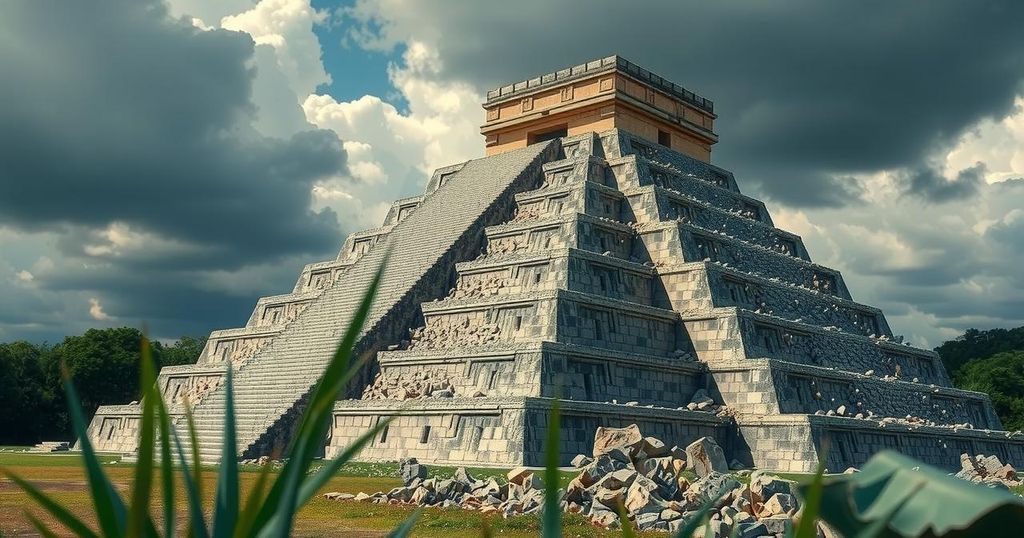Pyramid Collapse in Mexico Highlights Climate Change Impact on Heritage
A pyramid in Ihuatzio, Mexico, collapsed on July 29, 2024, under extreme weather conditions, illustrating the effects of climate change on cultural heritage. Once a key symbol of the Michoacán Kingdom, the pyramid’s damage underscores wider vulnerabilities across heritage sites globally due to rising seas and severe weather. Perspectives from indigenous culture provide a context for interpreting these changes.
In a disturbing incident due to extreme weather conditions, a 15-meter-high pyramid in Ihuatzio, Michoacán, Mexico, collapsed during a torrential downpour on July 29, 2024. This monument, once a symbol of the Michoacán Kingdom’s heritage, had withstood centuries but succumbed to the erosion caused by heavy rains following a prolonged drought. According to specialists from Mexico’s National Institute of Anthropology and History (INAH), this collapse showcases the vulnerability of significant archaeological structures in the face of climate change. The pyramid stood at a renowned archaeological site alongside another pyramid, a fortress, and several tombs, originally inhabited by Nahuatl-speaking peoples over 1,100 years ago, and later by the P’urhépechas, an empire that resisted Aztec conquests. Although only one pyramid was damaged, officials revealed that at least six other structures at the site require extensive repairs due to similar environmental pressures. The recent weather patterns have included unprecedented rainfall and storms, occurring after the worst drought in Mexico’s last three decades. These conditions exacerbated pre-existing vulnerabilities within the monument’s structure, leading to its inevitable collapse. An INAH statement attributed the structural failures primarily to water infiltration following cracks formed during the preceding drought. This incident is part of a broader trend affecting global cultural heritage sites. Extreme weather and rising sea levels—consequences attributed to anthropogenic climate change—pose increasing risks to heritage sites worldwide. For instance, archaeologists have noted damage to ancient cave paintings in Oceania, while a study highlighted the dangers to historic buildings in both Europe and Mexico stemming from increased precipitation. A descendant of the P’urhépecha tribe, Tariakuiri Alvarez, remarked that his ancestors would have viewed the pyramid’s collapse as a “bad omen,” signaling the displeasure of the gods, a sentiment reflecting the deep cultural ties to such heritage. Alvarez’s perspective underscores the spiritual implications of these developments, drawing a connection to historical occurrences preceding the arrival of foreign colonizers in Mexico. Further compounding the scenario, similar eroding phenomena were evident earlier in 2024, such as the collapse of Utah’s renowned ‘Double Arch’ due to shifting water levels and erosion, which underscores the pervasive impact of climate change on natural and cultural landmarks alike. As these treasured heritage sites face devastation from climate variations, it emphasizes a crucial responsibility to advocate for their preservation for future generations. The observable damage wrought by our actions is undeniably disheartening, reminding us of the fragility of both our cultural legacies and our natural environment.
The article discusses the collapse of a significant pyramid in Michoacán, Mexico, attributed to extreme weather conditions intensified by climate change. It highlights the historical significance of the pyramid and the archaeological site of Ihuatzio, reflecting on the culture of the P’urhépechas and their resistance against Aztec domination. The incident serves as an illustration of the broader issue of environmental threats facing cultural heritage worldwide, particularly due to climate change impacts such as rising seas and extreme weather events. The commentary from local community members adds a cultural perspective on the meanings attributed to such natural disasters.
In conclusion, the recent collapse of the pyramid in Ihuatzio, Mexico, serves as a stark reminder of how climate change profoundly impacts cultural heritage. The combination of extreme weather events and rising sea levels poses critical challenges for the preservation of significant archaeological sites worldwide. The perspectives shared by local indigenous communities underscore the intersection of cultural heritage and environmental stewardship. It is imperative that protective measures are initiated to safeguard these invaluable sites for the enlightenment of future generations.
Original Source: www.sciencealert.com




Post Comment